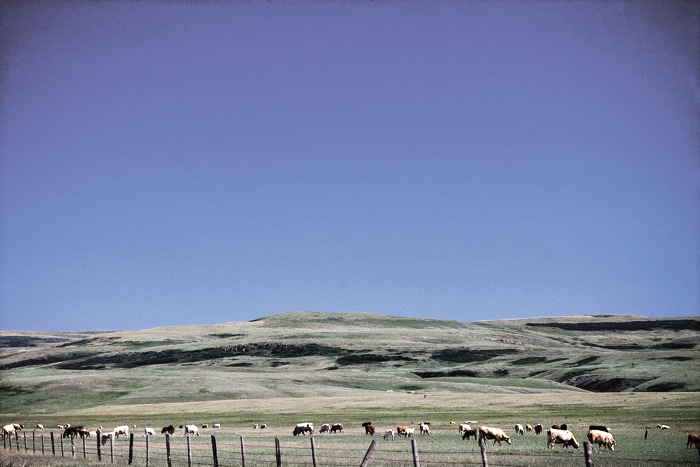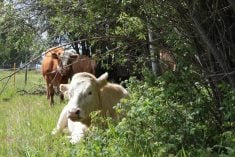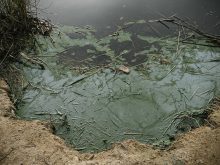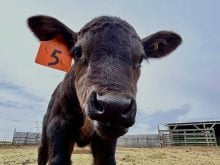With the current lack of runoff moisture and few spring rains across much of Western Canada, certain disease conditions may become more prevalent. It will pay to be extra vigilant this year when checking your herds.
We commonly see more blackleg and all the other clostridial diseases in dry conditions. With shorter grass, cattle and bison graze closer to the soil and increase the likelihood of picking up the organisms. Also slough holes, creek bottoms and other areas normally covered by water are exposed.
All livestock must receive preventative vaccinations and that includes mature stock if they have not had booster shots within a maximum of two years or less.
Read Also

Cancer agency reclassifies another herbicide ‘probably carcinogenic’
The WHO’s cancer research agency has now put atrazine, a herbicide well known to corn growers, in the same potential-hazard category where the agency put glyphosate.
Anthrax
Anthrax is fatal as well and although very rare is often traced to these dried-out waterways. There is a vaccine for it, but generally it is only given in outbreaks or if a history in the area. Generally if it has been diagnosed in a herd, surrounding herds are vaccinated as well. The federal veterinarians (CFIA) no longer look after control of anthrax or removal and disposal of dead animals. Vaccination is then considered for several years subsequent and close neighbours may consider it.
Any producer along the same waterway may need to consider vaccination and should consult with his/her veterinarian. Always have a complete autopsy performed by your veterinarian in any sudden deaths of cattle you find to rule out these diseases. Private veterinarians through the provincial associations now can access quick tests on blood for the determination of anthrax. This could become a great help because if we suspect anthrax we are not supposed to open up the carcass.
Parasites
We always think of internal parasites being a problem in wet weather. This is for the most part true and desiccation (drying) does wonders to kill the parasitic larvae. However livestock, especially calves, will be grazing very close to the manured sites and may pick up parasites. Calves, because they are so inquisitive will eat whatever is available. If grass is short, picking at manure patties and licking dirt may become a pastime. This is especially true if being dry fed in confinement.
An easy check is to run routine fecals on about 10 per cent of the group in the summer. If worms are a problem they will be shedding at this time. Dewormers can often be placed in the minerals or feed to avoid bringing everyone back from pasture. Calves do not eat much mineral yet in studies they eat enough to get the medication for internal worms. Deworming results in gains up to 20 to 30 pounds over an average summer. In a drought condition we definitely can’t afford to be feeding worms and the extra feed efficiency helps as well.
Respiratory issues
With dry conditions come dust and other particulate matter in the air. Regular movement will stir this dust up. Often the respiratory tract is overtaxed clearing out this debris. Coughing is the normal response to purging the respiratory passages. If too much coughing is evident, watch closely as pneumonia can be the sequelae, or secondary result.
This year especially young calves will be hardest hit and even when moved out to pasture the dust has been unavoidable. In some cases mass medication of the calves has been necessary. Many producers now are also vaccinating the younger calves for the respiratory bacteria as well as the viruses. Many are using the new intranasal products that are out there
If coughing is evident in many of the herd always keep in mind lungworms. Even though it needs moisture to complete the life cycle, Watch the grazing pattern of the livestock. With drier conditions cattle, bison and other herbivores will seek out lower, wetter areas where vegetation is more plentiful. This is where exposure to the lungworm larvae may happen. Again fecal tests specifically for lungworm can help diagnose this condition if you suspect it. Alberta and Saskatchewan seem to be the two provinces we see lungworms in the most.
Water quality
With drought, water sources become taxed. All the issues with water quality need to be addressed. Blue-green algae will proliferate as organic matter builds up. Contamination by coliform bacteria and other water borne organisms such as giardia proliferate. You need to maximize water preservation by using the solar or wind pumps. This also improves water quality. Dugouts become extremely hazardous for calves getting stuck or bogged down especially if weak from another illness.
Toxic plants
Cattle may also start to forage on less desirable weeds such as stinkweed, lambs quarter, tansy, horsetail, locoweed, water hemlock and several others. Each of these plants has varying degrees of toxicity so watch for them if pastures get too low. Your veterinarian will know which toxic plants are resident in your local area and advise if there are any other diseases or health issues to worry about.
Management options
In a dry spell many management decisions need to be altered and health monitoring is one of them. We have producers in our area contemplating early weaning and implementing a deep cull on their cow herd in order to better utilize grass shortages. Early pregnancy checking is another way to cull early allowing only the pregnant cows to complete the grazing season. Fewer cattle will extend the grazing season.
Let’s always communicate as to specific conditions the local region is encountering. Veterinary clinic newsletters, provincial surveillance programs and neighbours talking among themselves allows us to help each other when strange environmental issues lead to disease emergence.















